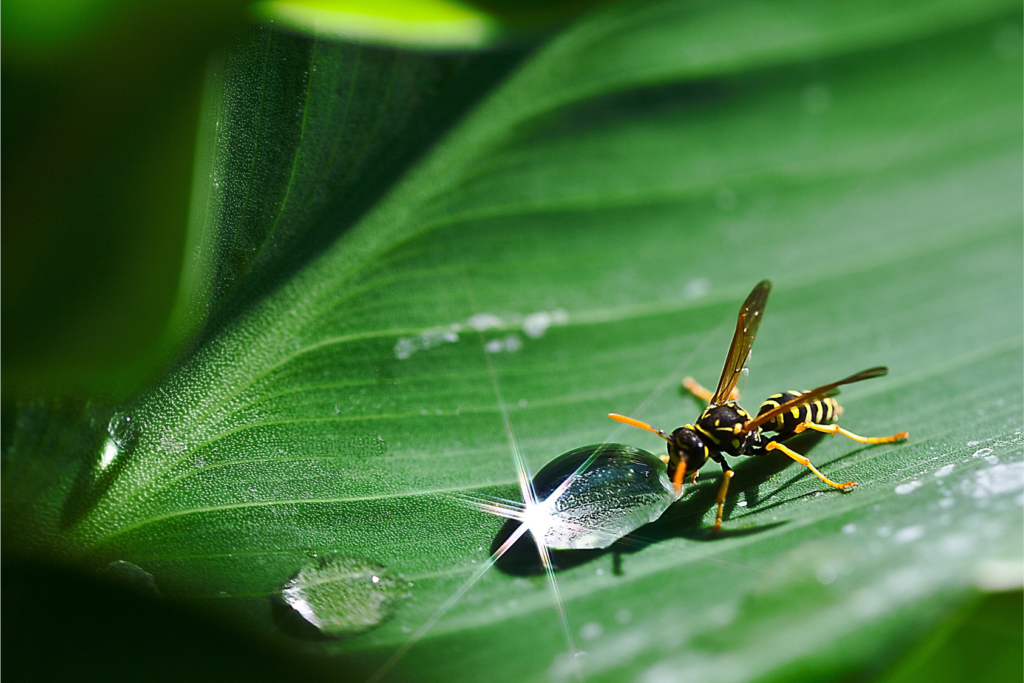By Michael Shook
I finally got around to staining the gates in the back of the property this month. They were holding up well, but red cedar does last longer with some protection. So, back I went, stain bucket in hand, brush in the other. As I approached the largest of the gates, I could see two unmistakable forms thereon – bald-headed wasps.
They paid no attention to me. I stood back a couple of feet and watched them work. They were gnawing away industriously at the softest part of the wood grain, gathering it up for nest material. I looked around at the surrounding woods and brush, wondering if their house was nearby. If it was, I wanted to make sure I knew where, for obvious reasons. Years ago, on a firewood expedition, I’d blundered into a bald-faced nest, and got a sting on the ear (ouch), lost an expensive, custom-made earplug when I whacked at the beast, and then got to experience the worst headache I’ve ever had.
However, nothing dramatic or painful occurred this time. They left, and I examined the wood. The gates are a simple rectangular frame of 2 x 4 cedar, with a 1 x 4 cedar “X” brace, and deer fence wire attached. Over the nine years the gates have been up, various wasps have left the wood of all the surfaces sculpted, such that the softest, widest grain forms small valleys between the much harder ridges of stout grain. It is remarkable how much has been spirited away, and made into paper.
We have many wasps around our place. The larger, more fierce varieties – bald-faced, black-and-yellow (both called hornets, but not truly so), and the much smaller (but exceedingly cranky) ground-dwelling yellowjackets – rarely if ever build on the house, or near it. Far on the other end of the scale from such surly creatures are two favorite visitors, who only show themselves occasionally: the Great Golden Digger wasp and the Cuckoo wasp. Both of these are nectar-feeders and are quite docile. The Cuckoo has a tiny stinger and is so retiring it will usually simply curl up if badgered by a human. Both of these wasps, however, have a trait that is irresistible to me, and that is beauty.
The Cuckoo is at most a mere 5/16ths of an inch in length, but its bright, metallic green is impossible to miss on a flower – a tiny, glimmering fragment of emerald, often carrying with it what appears to be luggage – saddle-bags of yellow pollen.
The Golden Digger is much larger, about 1-inch plus in length, and is a delight. Their legs, the latter part of the thorax, and the first two-thirds of the abdomen, are a stunning amber gold that seems to glow from within. The head is mostly black, and there is a black accent band on the tail end that supplies an elegant finish. The wings are likewise amber, but delicately translucent, with, again, black on the tips. If I let the mint plant in its container go to flower, they will visit it by the score, wings shimmering in the sun as they move from blossom to blossom.
There is another important species I should mention – the European paper wasp. It arrived here in the 1980s or so, and is now ubiquitous across Canada, the United States, and Mexico. Are they originally French? German? Perhaps Italian, or maybe Dutch, tolerant peoples both, and these wasps are the same, roughly – at least, for wasps. They love to make their homes in the undulations that form the center part of the metal roofing panels covering our house, garage, and shed. They also build under ledges, like the ones formed by the boards we placed to sit on and pick blueberries from the plants in raised beds. Roughly estimating, we’ve got at least hundreds, maybe more. Thank goodness they are not aggressive. As long as I am not bashing about their housing, I can work right next to them without a problem.
However, while picking blueberries the other day, I did just that, trying to untangle some of the bird netting. A moment before I saw them swarming (if 7 or 8 can be a swarm – their nests are usually small), I felt a searing jab in my hand, near my thumb joint. Ouch, again.
Well, that was largely my responsibility. The initial pain faded quickly, and while I had to put up with some swelling and terrific itching for the week it took my body to process the venom, it was, overall, a minor thing. And the benefits of having so many of these and other wasps around the place is the near-complete absence of aphids and noxious caterpillars. With so many predators around, it’s easy and fun to watch them all as they hunt, foraging around under and through the daphne, jasmine, osmanthus, kinnikinnick, and so on, as well as the blueberries. The European wasps generally stay low in the garden cover, but will also venture into trees to eat tent caterpillars, a larva so foul-tasting birds won’t touch them. It makes me think they – the Euros – couldn’t be Italian after all. No Italian I ever met would eat such awful food.

